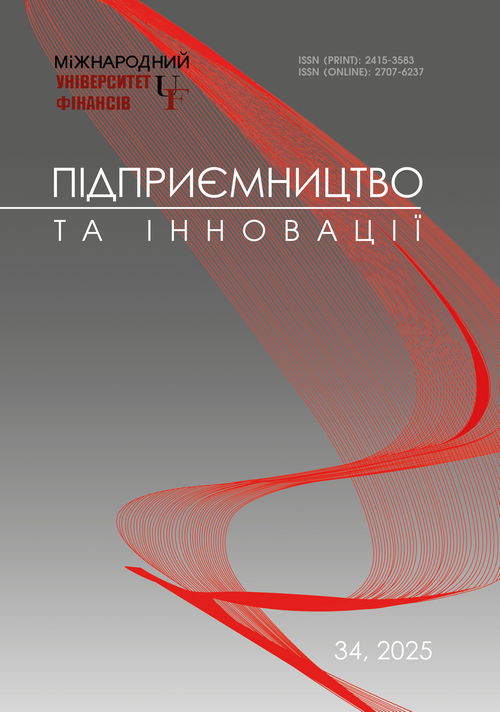INNOVATION-CLUSTER MODEL OF REGIONAL ECONOMY DEVELOPMENT: CONCEPTUAL FEATURES, BENEFITS, AND CONSTRAINTS
Abstract
The article focuses on exploring the role of innovation-cluster development models for regional economies, especially in terms of enhancing their competitiveness. The core argument is that the competitiveness of regions cannot rely only on specific products or sectors but is defined by the effective interaction of economic agents at the regional level. The key mechanism for such interaction lies in inter-sectoral complexes, or clusters, which bring together businesses, financial institutions, and research and educational entities, promoting a synergy between innovation and economic potential. This article explores the theoretical basis of clusters, specifically focusing on the concept introduced by M. Porter and M. Enright. M. Porter, the founder of the cluster approach, defined clusters as geographically localized groups of interconnected companies and cooperating and competing institutions to achieve common competitive advantages. It also addresses the concept of ‘smart specialization’, which guides the development of innovative clusters by capitalizing on the unique strengths of each region, emphasizing the modernization of traditional sectors and the incorporation of cutting-edge technologies. The innovation-cluster approach acquires special significance in the context of digitalization and information progress. It enables the aggregation of high-tech resources and innovations within particular areas, fostering the growth of local enterprises while also increasing the investment attractiveness of the regions. Clusters play an important role as cells of technological and social change, creating conditions for the development of new market niches and increasing export potential. Despite many advantages, innovation-cluster models have certain restrictions. One of the major challenges is the cluster disintegration probability due to external economic changes, as well as fluctuations in demand or changes at international markets. Furthermore, managing clusters can become complicated due to indistinct geographical and organizational boundaries, which hinder effective coordination of activities. Within this context, the prevalence of large transnational corporations may limit the involvement of small and medium businesses, which diminishes their interaction and collaboration within the cluster. It has been highlighted that innovation-cluster models should be viewed as the component of a wider regional innovation system that must evolve in alignment with the national economy. Considering both common and unique features of innovation clusters can provide the basis for crafting a successful regional development strategy, boosting their competitiveness, and fostering sustainable economic progress.
References
Буряк Є.В., Солоха Д.В., Павловська А.С. Процеси інтеграції і перспективи формування регіональної кластерної політики на основі балансу економічних інтересів. Проблеми та перспективи забезпечення стабільного соціально-економічного розвитку. Серія: Економіка: зб. наук. праць Донецького держ. ун-ту управління. 2019. Вип. 314. С. 17-29.
Гоменюк М.О. Кластер як інноваційна форма територіального розвитку. Науковий вісник Мукачівського державного університету. Серія: Економіка. 2019. Вип. 11 (1). С. 76-81.
Зінченко О.А. Культура інноваційних кластерів як іміджева компонента регіонального розвитку. Вісник Східноєвропейського університету економіки і менеджменту. Серія : Економіка і менеджмент. 2017. Вип. 1 (22). С. 19-27.
Клюс Ю.І. Корпоративна система управління інноваціями : формування та розвиток: монографія. Лисичанськ : ПромЕнерг, 2015. 238 с.
Кузьмін О., Жеруха В. Кластери як чинник економічного розвитку підприємств і територіальних утворень. Економіка України. 2010. № 2. С. 14-23.
Міщенко В.А. Регіональний підхід до формування інноваційних кластерів. Science, theory and practice : abstracts of 29th Intern. sci. and practical conf., June 08-11, 2021. Tokyo : International Science Group, 2021. Р. 227-232.
Ніколаєнко С.М. Розвиток процесів кластеризації Фінляндії. URL : https://dspace.nuft.edu.ua/server/api/core/bitstreams/ac065d8e-e12e-4997-82ed-c916bb40d752/content
Новікова О.Ф., Амоша О.І., Антонюк В.П. та ін. Сталий розвиток промислового регіону : соціальні аспекти: монографія. Донецьк, 2012. 534 с.
Юр’єва П.Б. Територіальні інноваційні кластери та стійкий економічний розвиток регіонів. Економіка та суспільство. 2024. Вип. 63. URL: https://economyandsociety.in.ua/index.php/journal/article/view/4079
Enright M.J. Why Clusters are the Way to Win the Game? Word Link. 1992. № 5. Р. 46-52.
Porter M. Building the microeconomic foundations of prosperity: Findings from the microeconomic competitiveness index. In The World Economic Forum’s Global Competitiveness Report 2002-2003. Oxford : Oxford University Press. 2002. Р. 23-45.
Porter M. Location, competition, and economic development: local clusters in a global economy. Economic Development Quarterly. 2000. № 1. P. 15-20.
Solvell O., Lindqvist G. and Ketels C. The Cluster Initiative Greenbook, Gotheburg. Competitiveness Institute, 2003.
Buriak Ye. V., Solokha D. V., Pavlovska A. S. (2019) Protsesy intehratsii i perspektyvy formuvannia rehionalnoi klasternoi polityky na osnovi balansu ekonomichnykh interesiv [Integration processes and prospects for the formation of a regional cluster policy based on the balance of economic interests]. Problems and prospects for ensuring stable socio-economic development, vol. 314, pp. 17-29.
Homeniuk M. O. (2019) Klaster yak innovatsiina forma terytorialnoho rozvytku [Cluster as an innovative form of territorial development]. Scientific Bulletin of Mukachevo State University, vol. 11 (1), pp. 76-81.
Zinchenko O. A. (2017) Kultura innovatsiinykh klasteriv yak imidzheva komponenta rehionalnoho rozvytku [Culture of innovative clusters as an image component of regional development]. Bulletin of the Eastern European University of Economics and Management, vol. 1 (22), pp. 19-27.
Klius Yu. I. (2015) Korporatyvna systema upravlinnia innovatsiiamy : formuvannia ta rozvytok [Corporate innovation management system : formation and development]. Lysychansk: PromEnerg. (in Ukrainian)
Kuzmin O., Zherukha V. (2010) Klastery yak chynnyk ekonomichnoho rozvytku pidpryiemstv i terytorialnykh utvoren [Clusters as a factor in the economic development of enterprises and territorial entities]. Economy of Ukraine, no. 2, pp. 14-23.
Mishchenko V. A. (June 08-11, 2021) Rehionalnyi pidkhid do formuvannia innovatsiinykh klasteriv [Regional approach to the formation of innovation clusters]. Proceedings of the Science, theory and practice : 29th Intern. sci. and practical conf. Tokyo: International Science Group, pp. 227-232.
Nikolaienko S. M. Rozvytok protsesiv klasteryzatsii Finliandii [Development of clustering processes in Finland]. Available at : https://dspace.nuft.edu.ua/server/api/core/bitstreams/ac065d8e-e12e-4997-82edc9-16bb40d752/content
Novikova O. F., Amosha O. I., Antoniuk V. P. ta in. (2012) Stalyi rozvytok promyslovoho rehionu : sotsialni aspekty [Sustainable development of the industrial region: social aspects]. Donetsk. (in Ukrainian)
Yurieva P. B. (2024) Terytorialni innovatsiini klastery ta stiikyi ekonomichnyi rozvytok rehioniv [Territorial innovation clusters and sustainable economic development of regions]. Economy and society, vol. 63. Available at : https://economyandsociety.in.ua/index.php/journal/article/view/4079
Enright M. J. (1992) Why Clusters are the Way to Win the Game? Word Link, no. 5, pp. 46-52.
Porter M. (2002) Building the microeconomic foundations of prosperity : Findings from the microeconomic competitiveness index. In The World Economic Forum’s Global Competitiveness Report 2002-2003. Oxford : Oxford University Press, pp. 23-45.
Porter M. (2000) Location, competition, and economic development : local clusters in a global economy. Economic Development Quarterly, no. 1, pp. 15-20.
Solvell O., Lindqvist G., Ketels C. (2003) The Cluster Initiative Greenbook, Gotheburg. Competitiveness Institute.



